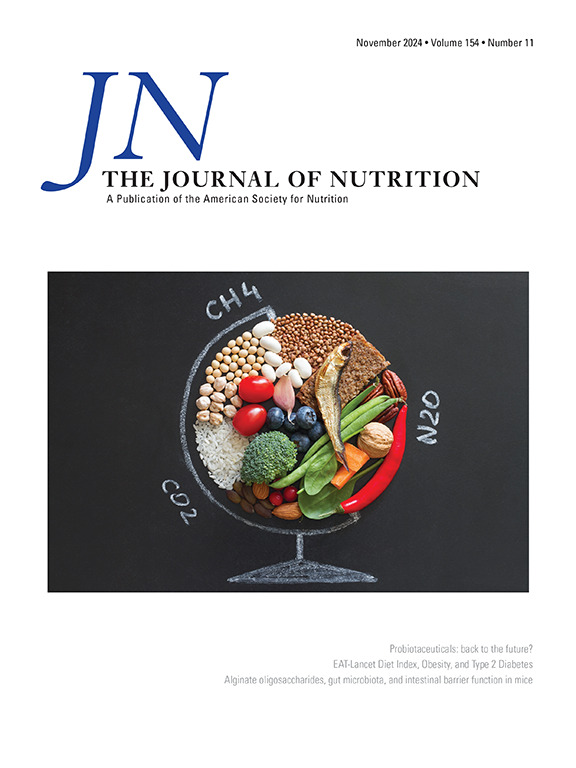Dietary Branched-Chain Amino Acids Restriction in High-Fat Diet-Induced Obese Mice: Effects on Metabolic Homeostasis, Adipose Inflammation, and Gut Microbiota
IF 3.8
3区 医学
Q2 NUTRITION & DIETETICS
引用次数: 0
Abstract
Background
Numerous studies implicate a strong association between elevated circulating branched-chain amino acids (BCAAs) and obesity and related disorders. However, whether this association is causal, and if disrupted BCAA homeostasis can serve as a therapeutic target for obesity-related diseases remain to be established experimentally.
Objectives
We aimed to explore the long-term effects of BCAAs restriction on lipid and glucose metabolism, adipose inflammation, and gut microbiota in high-fat diet (HFD)-induced obese mice.
Methods
Three-month-old male C57BL/6J mice were divided into 3 groups and received a semi-purified ingredient control diet, HFD, or HFD with 50% BCAAs restriction for 24 wk. Body weight, fasting serum BCAAs, glucose, insulin, total cholesterol, triglycerides, low-density lipoprotein cholesterol, high-density lipoprotein cholesterol levels, and glucose tolerance were measured. Inflammation markers and macrophage infiltration in epididymal adipose tissue, as well as gut microbiota profiling, were conducted. Differences between groups were analyzed by one-way analysis of variance or Wilcoxon rank-sum test.
Results
HFD feeding significantly increased circulating leucine, isoleucine, valine, and total BCAAs levels by 31%, 27%, 19%, and 25%, respectively, compared with the control group (P < 0.05). Compared with the HFD group, dietary BCAA restriction significantly decreased circulating leucine, isoleucine, and total BCAAs levels by 21%, 17%, and 16%, respectively (P < 0.05). However, this reduction was not sufficient to improve glucose and lipid homeostasis, except for a significant 20% reduction in serum LDL levels (P < 0.05). Additionally, BCAA restriction failed to decrease white adipose tissue mass index or alleviate epididymal adipose tissue inflammation HFD-fed mice. Interestingly, BCAAs restriction ameliorated HFD-induced gut microbiota disorder by downregulating the Firmicutes/Bacteroidetes ratio (P < 0.05) and reducing the relative abundance of obesity-linked bacteria, such as Lactococcus and Oscillibacter (P < 0.05).
Conclusions
Collectively, the results suggest that although BCAA restriction may have limited benefits on HFD-induced obesity and metabolic disorders in mice, it improves gut microbiota dysbiosis.
高脂肪饮食诱导的肥胖小鼠饮食支链氨基酸限制:对代谢稳态、脂肪炎症和肠道微生物群的影响
背景:大量研究表明,循环支链氨基酸(BCAAs)升高与肥胖及相关疾病之间存在密切关联。然而,这种关联是否存在因果关系,以及BCAA平衡被破坏是否可以作为肥胖相关疾病的治疗靶点,仍有待实验证实。目的:我们旨在探讨支链氨基酸限制对高脂肪饮食诱导的肥胖小鼠脂质和糖代谢、脂肪炎症和肠道微生物群的长期影响。方法:将3月龄雄性C57BL/6J小鼠分为3组,分别饲喂半纯化成分对照饲粮、高脂饲粮(HFD)和限制50%支链氨基酸的高脂饲粮,持续24周。测量体重、空腹血清BCAAs、葡萄糖、胰岛素、总胆固醇、甘油三酯、低密度脂蛋白胆固醇、高密度脂蛋白胆固醇水平和葡萄糖耐量。研究了附睾脂肪组织中的炎症标志物和巨噬细胞浸润,以及肠道微生物群谱。组间差异分析采用单因素方差分析或Wilcoxon秩和检验。结果:与对照组相比,HFD喂养显著提高了循环亮氨酸、异亮氨酸、缬氨酸和总BCAAs水平,分别提高了31%、27%、19%和25% (p结论:总体而言,结果表明,尽管限制BCAA对HFD诱导的小鼠肥胖和代谢紊乱的益处有限,但它改善了肠道微生物群失调。
本文章由计算机程序翻译,如有差异,请以英文原文为准。
求助全文
约1分钟内获得全文
求助全文
来源期刊

Journal of Nutrition
医学-营养学
CiteScore
7.60
自引率
4.80%
发文量
260
审稿时长
39 days
期刊介绍:
The Journal of Nutrition (JN/J Nutr) publishes peer-reviewed original research papers covering all aspects of experimental nutrition in humans and other animal species; special articles such as reviews and biographies of prominent nutrition scientists; and issues, opinions, and commentaries on controversial issues in nutrition. Supplements are frequently published to provide extended discussion of topics of special interest.
 求助内容:
求助内容: 应助结果提醒方式:
应助结果提醒方式:


